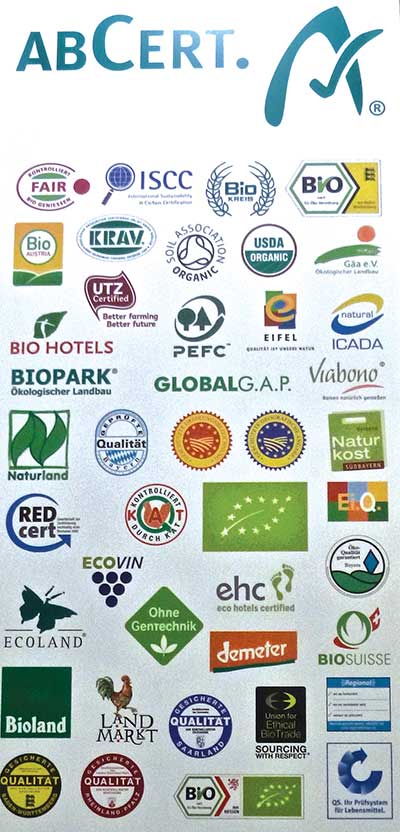 |
| All the different organic logos in Europe, displayed at Biofach in Nuremberg. Photo by the author. |
By Jacomijn Schravesande-Gardei, Associate Director of Crops, MOFGA Certification Services, LLC
A few years ago I had the pleasure of attending an IFOAM organic leadership course in Europe. IFOAM, the International Federation of Organic Agriculture Movements, is the worldwide umbrella organization for the organic agriculture movement. Participants from all over the world came together to discuss and learn about that movement. One reason I wanted to participate in this course was to learn more about organic certification in Europe. At MOFGA, I am frequently asked how Europeans “do” organic certification, since I grew up in the Netherlands. But I did not get involved in organic certification until I moved to Maine, so I was not quite sure. The course and subsequent readings taught me a little.
In the European Union, about 5.6 percent of farmland is managed organically (versus about 0.8 percent in the United States). Almost 30 percent of the certified organic agricultural land worldwide is in Europe, according to the European Commission. Interestingly, in 2012, 44 percent of retail sales of organic products worldwide were in the United States while 41percent were in the European Union, according to the FIBL-IFOAM Survey on Organic Agriculture Worldwide 2014. (Currently, the EU population is about 512.5 million, while the U.S. population is about 326.8 million.)
Organic production has been regulated at the EU level since 1991, with requirements set by the Council Regulation. In March 2002 the European Commission issued an EU-wide label for organic food. This label has been mandatory throughout the EU since July 2010. All products labeled as organic and sold in the EU must be produced in accordance with these regulations and use this EU-wide label. This is similar to development of the USDA National Organic Program (NOP) organic rules.
Under EU organic standards, each member state (e.g., Germany, France) establishes a competent authority to regulate organic products. One difference between U.S. and EU rules is that in addition to the EU label, many other labels were developed long before the advent of the EU organic regulations. Using these other labels shows organic shoppers that the requirements of the EU regulations have been exceeded. Member states also still use different procedures when residues of non-allowed substances are detected on organic foods.
However, changes are afoot in Europe. In 2014 the EU Commission published a proposal for a new organic regulation. After being discussed by the EU Parliament and Council, the new regulation was published on June 14, 2018, and will go into effect on January 1, 2021, according to Ifoam-eu.org. Interestingly from the U.S. perspective, the new regulations encourage short distribution channels and local production. For livestock farmers a higher percentage of feed must come from the farm itself or at least from the same region. Also, the EU has decided that annual inspections will not be mandatory for everyone and should be risk-based. Low-risk farms will be inspected every two years instead of every year; the latter is the case in Europe and in the United States now.
Equivalency
Can products certified in Europe be sold in the United States and vice versa?
The United States has an equivalence arrangement with the European Union. As long as the terms of the arrangement are met, products certified to the USDA organic or EU organic standards may be labeled and sold as organic in both countries.
Looking at the specific standards, the U.S. organic standards are similar to the EU organic standards. However, a few exceptions exist, and conditions of the agreement are based upon these. For example, in the United States antibiotics cannot be administrated to livestock. So under the arrangement, if a farmer wants to export organic livestock to the United States from the European Union, that livestock cannot have been treated with antibiotics. Farmers can get import certificates from their certifiers attesting to compliance of the terms of the arrangement. This import certificate also allows the product to be traced. MOFGA Certification Services has issued a number of these certificates for our clients who sell their products in the European Union.
I think that Maine farmers and consumers are interested in the EU certification process because labels exist in Europe that show that certified operations exceed EU standards. The USDA regulations do not allow USDA NOP accredited certifiers to certify to higher standards than other NOP accredited certifiers. However, many producers are talking about an add-on label to organic certification, such as the Real Organic Project, the Regenerative Organic label or the Agricultural Justice Project. That’s a topic for another MOF&G!

